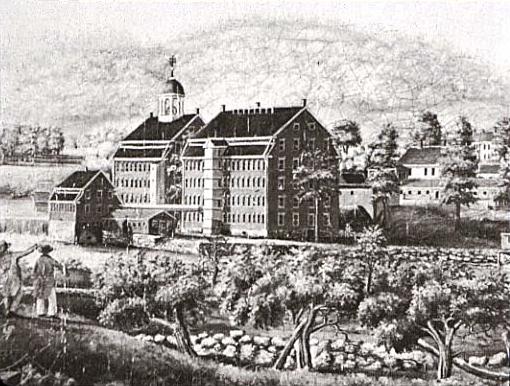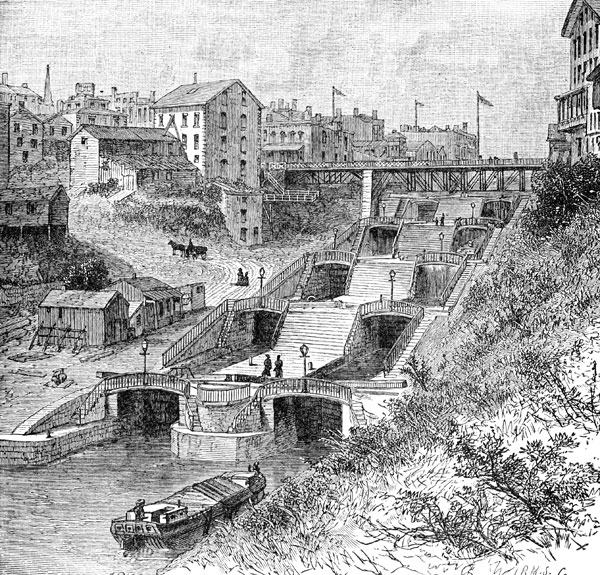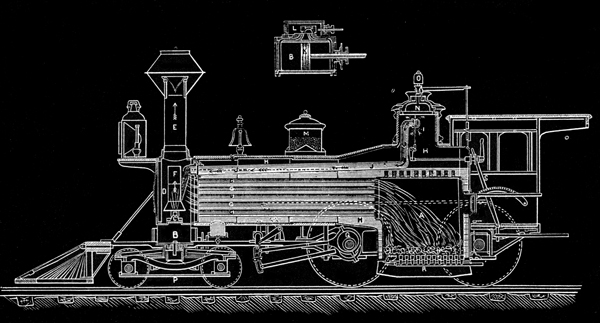
Topics on the Page
Two Distinct Economies and Cultures
Industry in the North
Agriculture in the South
A Divided Country
Outlooks Leading to War
Sectional Politics
Women's Roles and Perspectives
 United States History Cross-Links
United States History Cross-Links
Focus Questions:
What were the different economies and cultures of the North and the South and how did they contribute to sectional differences in the years before the Civil War?
How did the expansion of the United States contribute to the growing importance of sectional politics in the early 19th century and significantly influence the balance of power in the federal government?
Page Summary
The expansion of the United States to the Midwest in the early 19th century contributed to the growing importance of sectional politics in the following ways:
- Divergent economic systems: The Midwest was primarily an agricultural region, while the Northeast was becoming more industrialized. This led to divergent economic interests and policies, with the Northeast favoring tariffs to protect its industries, while the Midwest opposed tariffs that would make imported goods more expensive.
- Expansion of slavery: As the United States expanded westward, the question of whether to allow slavery in new territories became increasingly contentious. The North opposed the expansion of slavery, while the South supported it. This created a growing divide between the two regions and contributed to the rise of sectional politics.
- Political representation: As more states were added to the Union, the balance of power in Congress shifted. The Midwest gained more representation, and its politicians began to assert their influence over national policies and legislation.
- Internal improvements: The Midwest relied heavily on infrastructure improvements such as roads, canals, and railroads to transport goods and support its growing population. However, the Northeast opposed federal funding for these projects, leading to further tensions between the regions.
All of these factors contributed to the growing importance of sectional politics in the early 19th century. As different regions of the country began to have increasingly divergent interests and priorities, politicians became more likely to align themselves with regional factions rather than with national parties. This trend would ultimately lead to the outbreak of the Civil War and a reshaping of American politics and society.
Here is a video about these differences.
Two Distinct Economies and Cultures
1) Two distinct economic cultures had arisen within the United States in the years before the Civil War, economic cultures that were similar to what caused the split of the American colonists from the British Empire in 1776. This led to distinct views of southern and northern nationalism.
- In the North, the people wished to preserve the Union at all costs while in the South, the concept of a new Southern republic was backed by many people.
- Yet the economic systems of the North and the South were actually quite complimentary. The agricultural production of the South was needed to support the rise of industrialization in the North and each system was dependent upon the other. Still the large majority of the free citizens of the United States lived in the North while slave labor dominated the South.
- Years of political patchwork and compromise only delayed the coming of the Civil War in 1861.
"Although there were serious differences between the sections, all of them except slavery could have been settled through the democratic process. Slavery poisoned the whole situation. It was the issue that could not be compromised, the issue that made men so angry they did not want to compromise. It put a cutting edge on all arguments. It was not the only cause of the Civil War, but it was unquestionably the one cause without which the war would not have taken place"
(The Civil War, Bruce Catton, Houghton Mifflin, 1960).
 Multimedia Resources
Multimedia Resources
Click here for a timeline of events leading up to the Civil war.
Slavery Crash Course
Pre-Civil War Crash Course
 |
| Boston Manufacturing Company, circa 1813-1816 |
Click here for a comprehensive history of Northern industrialization and the Antebellum South from the OpenStax College free US History E-Textbook.
Read this article to learn more about the North and South's reliance on each other and their seemingly opposing economic systems.
Here is an article about the immigrants that came to America in this time period
Read this overview of the differences between the North and South's economies and political makeups.
Watch this video for kids as an intro to how life was different in the North and South.
Industry in the North
2) Industry in the North was on the rise.
- It was importing raw materials from the South and from other countries and turning them into material products to be used by Americans and exported to nations across the globe.
Agriculture in the South
3) The South was based on an agricultural economy and, therefore, supported slavery.
- Large-scale plantations were utilized to create an environment of maximum output, which in turn would lead to maximum profit.
- The Democratic party of the South was committed to maintaining this lifestyle and was the major opposition to the Democrats of the North.
- The rise of the abolitionist movement in the North stood in marked contrast with the "necessity" of slave labor in the South.
- There were ideological and economic reasons to end slavery; while the morality of slavery was challenged for a long time, it was not a major push in the early days of the abolitionist movement.
Watch this video to find out more about cotton's central role in shaping the Southern economy and the rest of the US.
The Plantation Letters: Integrating Antebellum Plantation Life presents themes associated with traditionally underrepresented persons on antebellum plantations, namely slaves, women, and children.
Click here for an article from the Library of Congress about pre-Civil War African American slavery and national expansion and reform.
Click here for more on the South's agricultural economy and its reliance on slave labor from Digital History.
 See here for a collection of primary sources on the making of African American identity before the civil war.
See here for a collection of primary sources on the making of African American identity before the civil war.
A Divided Country
4) The different economies in the North and South led to the creation of a divided American culture.
- The North, based on industry and cities, and the South, based on the agrarian lifestyle, came into conflict with one another due to this difference.
- Different cultures and economies would lend themselves to distinct political needs, which would manifest in competing political parties.
- The North would largely support the Republican party, while the South would almost unanimously support the Democratic party: each with their own distinct views on the direction of law and policy in America.
- These parties were not the same as they are today- the Republican party was closer to the modern Democratic party and vice versa.
See these cultural divisions through the use of political cartoons.
Outlooks Leading to War
5) The economies and structures of both regions contributed to certain political outlooks that led to the Civil War.
- The North, which had industrialized, was much more connected and centralized and therefore supported the federal, over the state, government.
- The South, which was less centralized, was more divided up into the individual states of which it was comprised.
- They, therefore, advocated for states' rights over those of the federal government.
- In the end, these basic economic and cultural differences would erupt into the American Civil War.
 Analyze these primary sources to gain better understanding of these political divisions and then test your knowledge by answering the review questions.
Analyze these primary sources to gain better understanding of these political divisions and then test your knowledge by answering the review questions.
The Erie Canal and the swiftly growing system of railroads are key examples of how the North was steadily industrializing at a faster pace than the agrarian South.
 |
| Locks on the Erie Canal |
 |
| Diagram of a steam locomotive |
Sectional Politics

6) The rise of sectional politics would directly cause some of the major events leading up to the Civil War in 1861, including the Missouri Compromise, the Wilmot Proviso and the Lincoln-Douglas debates.
Click here for an interactive map of the Missouri Compromise.
 Watch this video for more on the cultural, economic, and political divisions between the North and South during the Antebellum Period from Khan Academy.
Watch this video for more on the cultural, economic, and political divisions between the North and South during the Antebellum Period from Khan Academy.
Here is a timeline of the events leading to the Civil War.

To receive a better understanding of the divisions in the United States, please check out Abraham Lincoln's House Divided Speech
- On the other hand, many prominent Southerners believed slavery actually helped further society. Check out this excerpt from South Carolina Senator James Henry Hammond chronicling his "Mudsill Theory"
- Here is a link to the text of a speech given by John Bingham of Ohio in the House of Representatives, on April 24, 1860. He discussed the issue of sectional politics and the speech provides an interesting look at his mindset.
- Here is a speech given in the House of Representatives on August 6, 1856, by Russel Sage. It is titled, "On the Professions and Acts of the President of the United States; the Repeal of the Missouri Compromise; the Outrages in Kansas; and the Sectional Influence and Aggression of the Slave Power."
Here is a link to a book written by Cicero W. Harris in 1902, The Sectional Struggle. Harris' book looks at various events beginning with the Compromise of 1833 and continues up to the Civil War. The Sectional Struggle offers some insight into the conflict between the North and the South throughout an extended period of time.
Noam Chomsky on the Legacy of Slavery
This video interview by Noam Chomsky explains the enduring legacy of slavery from the early years of the US through till the Civil War and into the present day. In many ways Chomsky asks us to consider if we have ever stopped fighting the Civil War. This is particularly pertinent given recent movements to dismantle Confederate statues/monuments that has been sweeping the South.
 Women's Roles and Perspectives
Women's Roles and Perspectives
- The set of ideals which shaped women's roles just prior to the Civil War is known by historians as "The Cult of True Womanhood". See here for how a woman's role changed due to the war.
- Click here to read an excerpt from Fanny Kemble's Journal called Journal of a Residence on a Georgian Plantation.
- The book, "The Sea Captain's Wife" serves as a great source of Northern perspectives of the period through the lens of a woman who was a sister of union soldiers and a wife of a confederate soldier.
This account of the African nanny-white child relationship outlined here further complicates the issues of humanity and human bondage in the Antebellum South.
 Teaching and Learning Resources
Teaching and Learning Resources
Click here for lesson plans and classroom resources on the "Growing Crisis of Sectionalism in Antebellum America" from EDSitement.
- Here is a link to a site from Teaching With Historic Places that contains several lesson plans dealing with a variety of aspects of the Civil War.
- Here is a link to lesson plans for Teachers and Students about the events leading to the Civil War.
- Here is a lesson plan for middle school students to create a timeline of the events leading to the Civil War.
Here is a link to a lesson plan on African-American communities in the North prior to the Civil War.
- To take a closer look at the Antebellum South, watch this lecture from Yale Open Course
- Also, make sure to look at its complimentary lecture focusing on the Yankee North here
- Finally, check out this overview lecture on the causes of the Civil War
- Here is a link to the text of "1861", by Walt Whitman.
- This is the poem that Professor Blight reads at the end of the "overview lecture."
Essay on the Social Changes of the Jackson Era [3]
http://jmisc.net/Jksn-era.htm
Works Cited:
[1] Feldmeth, G (1998). Sectionalism and National Growth. Retrieved April 18, 2007, from U.S. History Resources Web site: http://home.earthlink.net/~gfeldmeth/lec.sect.html
[2] (2006). Chapter Six: Sectional Conflict. Retrieved April 18, 2007, from From Revolution to Reconstruction Web site: http://odur.let.rug.nl/~usa/H/1994/chap6.htm
[3] (2007). Social Changes in Jackson Era U.S.A.. Retrieved April 18, 2007, Web site: http://jmisc.net/Jksn-era.htm
[4] (2007). Manifest Destiny: An Empire for Liberty or Slavery. Retrieved April 18, 2007, Web site: http://ppl.nhmccd.edu/~craigl/13.html
[5] Lincoln, A. (1858). A House Divided. Retrieved on April 3, 2010. Web Site: http://www.pbs.org/wgbh/aia/part4/4h2934t.html
[6]Hammond, J (1858) The Mudsill Theory. Retrieved on April 3, 2010. Web Site: http://www.pbs.org/wgbh/aia/part4/4h3439t.html
[7] Kemble, F (1863) Journal of a Residence on a Georgian Plantation.Retrieved on April 3, 2010. Web Site: http://www.pbs.org/wgbh/aia/part4/4h2922t.html
[8] (1998) Hayward and the Slave Louisa. Retrieved on April 3, 2010. Web Site: http://www.pbs.org/wgbh/aia/part4/4h3140.html
[9] Blight, D. (2008) Southern Society: Slavery, King Cotton, and Antebellum America's "Peculiar" Region. Retrieved on April 3, 2010. Web Site: http://www.youtube.com/watch?v=PunB5vPj2sE&feature=related
[10] Blight, D.(2008) A Northern World View: Yankee Society, Antislavery Ideology and the Abolition Movement. Retrieved on April 3, 2010. Web Site:http://www.youtube.com/watch?v=Pd1rB51xCzk&feature=PlayList&p=5DD220D6A1282057&playnext_from=PL
[11] Blight, D.(2008) Slavery and State's Rights, Economies and Ways of Life: What Caused the Civil War Retrieved on April 3, 2010. Web Site: http://www.youtube.com/watch?v=GscBDjPNBjM&feature=PlayList&p=5DD220D6A1282057&playnext_from=PL
[12] < http://ushistoryimages.com/steam-locomotive.shtm >.
[13] < http://ushistoryimages.com/erie-canal.shtm >.
Comments (0)
You don't have permission to comment on this page.